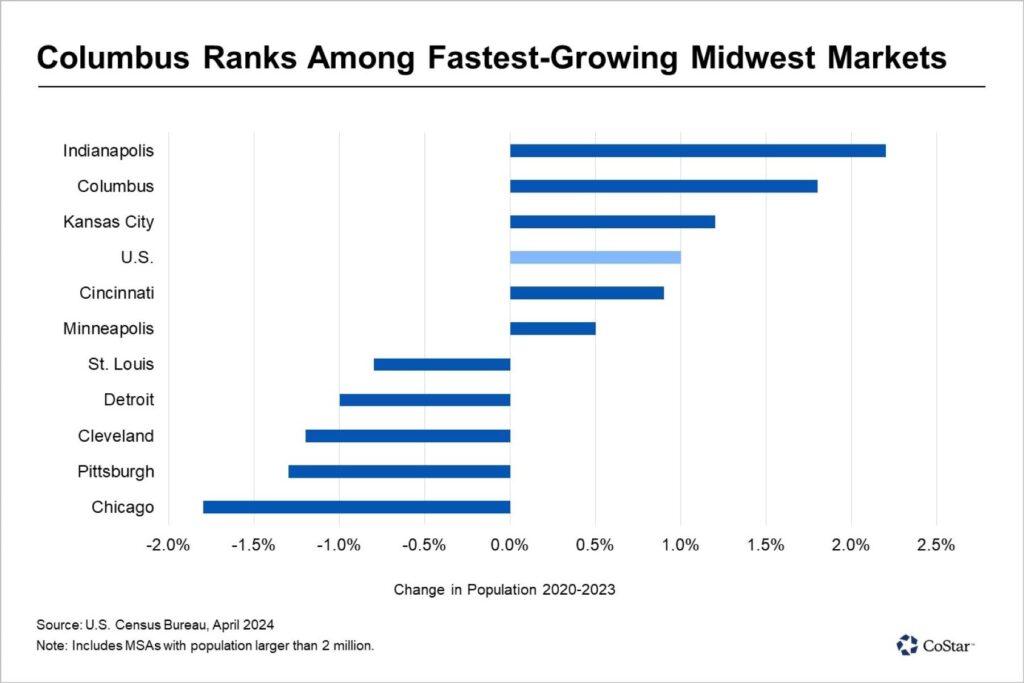Columbus Population Growth Outpaces National Average
Is It Time to Bury The Old Rust Belt Label for Good?

After years of living under the shadow of the “Rust Belt” label, strong job market and relative affordability is causing Columbus, Ohio’s population growth to outpace the national average. Columbus is also one of the fastest-growing markets by population in the Midwest, just behind Indianapolis, according to CoStar and the U.S. Census Bureau
The Columbus Metropolitan Statistical Area, which includes 10 counties, added just over 18,200 residents in 2023 from the prior year, or about 50 residents per day, according to the latest data from the U.S. Census Bureau. That is an increase of 0.8% compared to 0.5% for the country overall.
Since 2020, Columbus has added just over 38,000 people to its population, an increase of 1.8%. This places Columbus among the top 15 fastest-growing MSAs in the United States with at least 2 million residents and the second fastest among the Midwest, ranking just behind Indianapolis.
Why The Turnaround?
The surge in Midwestern MSAs can be attributed to several factors. Economic diversification has created a buffer against job losses, attracting a stability-seeking workforce. This is bolstered by a manufacturing revival, with cutting-edge facilities like EV gigafactories showcasing the region’s industrial resurgence. Additionally, the Midwest’s affordability advantage in housing, transportation, and daily expenses makes it attractive for families, young professionals, and retirees. Finally, the evolving quality of life, with strong communities, excellent schools, and abundant recreation, offers a desirable work-life balance for new residents.
The New Midwest Industrial Landscape – EVs and Microchips
The old “Rust Belt” is clearly experiencing a revival. After a long period of decline, the Midwest is now witnessing a surge in population and economic activity. A key driver of this resurgence is the return of manufacturing jobs, fueled by innovation and global supply chain trends.
Here’s a breakdown of the key factors fueling the Midwest’s manufacturing renaissance:
- Re-shoring of Manufacturing Jobs: Rising demand for electric vehicles (EVs) is driving the return of manufacturing jobs to the Midwest. Major companies are establishing cutting-edge EV gigafactories in cities like Columbus, Kansas City, and Indianapolis.
- Microchip Manufacturing Revival: The global push for domestic production chains is leading to the establishment of microchip manufacturing facilities in the Midwest. Both EV and microchip production require a skilled workforce, benefiting the regional economy. These are high wage jobs that tend to have a multiplier effect on other jobs
- Skilled Workforce Demand: This renewed focus on manufacturing creates jobs and fosters innovation, stimulating local economic growth.
Real Estate Resurgence: The economic growth fueled by manufacturing translates to increased demand for housing and commercial spaces. This surge in demand is contributing to the resurgence of real estate and population growth in the Midwest.
Columbus Unemployment Rate is Below the Statewide Average
Indeed, as the above data show, Columbus’ strong labor market is supporting healthy population gains. As of February 2024, the unemployment rate was 3.8% in Columbus, the tightest of Ohio’s major markets and well below the statewide rate of 4.4%.
Apartment developers are taking note of Columbus’ growing population. The total stock of apartment units has climbed 35% over the past decade, a faster pace than the national figure of 28%. Over the years, new supply in Columbus has tended to put a damper rent growth relative to some other markets like Cincinnati that do not experience as much new development.
Employment Gains Are Driving Increased Housing Demand
While Ohio State University is a consistent driver of apartment demand in Columbus, recent investments throughout central Ohio from advanced manufacturers should increase the need for more housing. In addition, Intel is building two wafer fabrication facilities in the Columbus area that are expected to generate 3,000 new jobs — though the project is facing delays for a second time and is now scheduled to be completed in 2026.
Honda is another employer that is making major investments in the Columbus and Dayton area. Honda’s joint venture with LG Energy Services is building a brand new EV battery plant in Jeffersonville (approximately 50 minutes southeast of Dayton) that is expected to bring more than 2,000 new jobs to the region. The new battery plant will cover the equivalent of about 78 football fields.
In total, Honda expects to invest more than $4 billion total into creating an “EV Hub” in Ohio, not only for the new battery plant in Jeffersonville, but also through retooling its Marysville and East Liberty assembly sites and its Anna engine plant. Dayton, Ohio is also seeing unprecedented levels of job growth amidst a Midwest investment boom driven by this renaissance in domestic manufacturing
With a tight labor market, affordable cost of living and growing advanced manufacturing sector, Columbus, Dayton, Indianapolis and many other cities in the Midwest could continue to see healthy population gains over the near term future, thus driving demand for additional housing.
